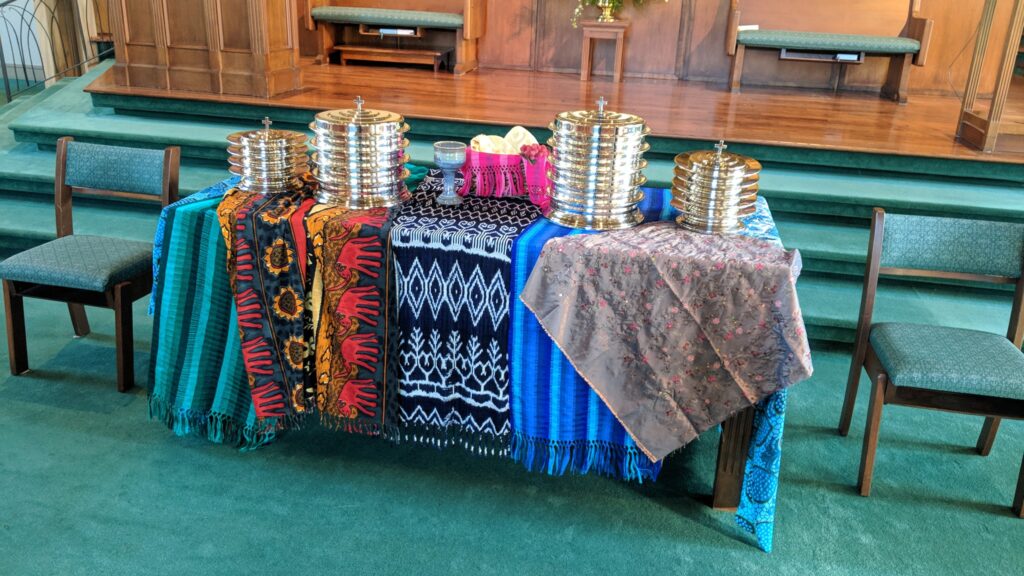In last week’s sermon, I mentioned this blog post, which failed to transition from my old “thepulpitandthepen.com” blog to this one. So I am posting it again.

The highlight of Christian worship is the Lord’s Supper. We break bread and share wine together, uniting ourselves through a very ordinary act with all the saints who have gone before us and to Christ himself. It’s a mysterious feast, especially for the stomach that often leaves the meal hungry.
The Bread
Standing in front of the table, the minister repeats Jesus’ words. “This is my body broken for you. Do this in remembrance of me.” In the Reformation, Protestants and Catholics fought over the meaning of these words—whether or not the bread was really Jesus’ body. Protestant Reformers could smugly point out that Jesus also said he was a door and nobody believes he is a literal door, wooden or otherwise. From the small portions used, you would think that all churches believed that it was Jesus’ actual body and they must hoard some for future generations. Of course, Protestants like me do not believe the bread is the literal body of Christ, but a sign to remind us of our unity with Christ in his death and resurrection.
The Wine
The second part of the service involves drinking wine or, as most Protestants prefer, grape juice. Again, Jesus’ words are spoken: “This cup is the new covenant sealed in my blood, shed for you for the forgiveness of sins.” In the Middle Ages, only priests were allowed to drink the wine because of a fear the common people might actually spill some. Only Jesus can shed his blood, they reasoned. In some churches, everyone drinks from the same cup, a nice gesture that demonstrate how we all share in Christ. However, the majority of American Protestant Churches understanding that such sharing involves germs; therefore, they use small individual cups about the size of a thimble. Since the women’s movement, most of these churches have begun using disposal plastic cups because no one is volunteering to wash the glass ones. Ecologically minded Christians are bothered by this waste, but until they sign up for cup washing, the trend toward plastic cups will continue.
Distribution methods
Christians participate in the Lord’s Supper in a variety of ways. Preferred methods resemble fast food. In most Methodist, Lutheran and Episcopal Churches, everyone goes up to the front of the sanctuary and kneels or stands, awaiting their turn to receive the bread and cup. The most common way in Baptist and Presbyterian churches is the drive-in method. Sitting in a pew, the elements are brought to you. A take-out plan is generally available for those unable to attend services.
Another method that has become more common is intinction. Each worshipper breaks off a piece of bread and dips it into the cup. This method rapidly facilitates the distribution of the elements, however the Biblical foundation for such a technique is weak. Even the most liberal exegete would have a hard time interpreting Jesus’ words, “take and eat” with “take and dunk.” More problematic for those sharing this method is that the only example we have of a disciple eating dipped bread in this manner at the Last Supper was Judas Iscariot.
Historical methods of celebration
A hundred or so years ago, it was common for American Protestants to actually sit around a real table and share a feast with others. This method, which had its roots in the Scottish Church, was the formal dining plan. To be allowed a seat at the table, a member produced a communion token. He or she earned these tokens by being good, paying one’s tithe, not breaking the commandments, and attending a preparatory lecture. After the preparatory lecture, they were given a communion token. As the worshipper approached the table, the maître’ d, a role played by an elder, greeted the worshipper. Those without a token to tip the maitre’ d, found themselves escorted to the door by the same elder who was also a bouncer. Once seated, the worshippers were served a hunk of bread and a cup of wine. This was done rapidly in order to accommodate the next seating. Unfortunately, for all its appeal, formal dining has gone the way of fine china and finger bowls. Few churches bother.
As Christians, we celebrate the Lord’s Supper in order to proclaim the life, death, and resurrection of Jesus Christ. We do this obediently and solemnly. Nobody talks; everyone bows their head. Most believe they conduct the service in the same manner as Jesus. But they have forgotten that Jesus instituted this sacrament at the Passover meal which consisted of four cups of wine. Unlike the Passover, a modern communion service lasts just a few minutes, after which everyone is still able to drive home.
The Hope
The celebration of the Lord’s Supper also serves as a foretaste of the kingdom to come. At the heavenly banquet, we will all sit at table with Christ at the head. The Bible doesn’t give us the menu, but considering that four of the disciples were fisherman, maybe it will be a seafood banquet. Or maybe lamb supplied by the good shepherd at the head table. Whatever the menu, the heavenly banquet promises to be livelier than the somber communion services. This is a good thing. Mark Twain noted that if heaven is just sitting around singing hymns, he couldn’t understand why anyone would want to go there. Likewise, if the heavenly banquet is only as exciting as its earthly counterpart, no one will RSVP.
The Reality
After communion, the minister pronounces the benediction. Like the flagman at Indianapolis, it signals the beginning of a race. Some parishioners rush out to a restaurant. In good Christian competition, they attempt to beat those from other churches. Others head home where the television is the first order of business. After finding the game of the week, one family pulls a roast from the oven while another grills burgers out back. Those without ambition order pizza. Such hearty food is served. As long as the right team wins, we laugh and love joyfully. After having fed us at his table, Jesus wonders why he’s not included.

I actually have vague memories of my grandparents’ church having the full scale celebration after services. I remember dozens of coolers being brought in before church as well as tables being setup outside, weather permitting.
I also remember us kids having to somehow not get our Sunday clothes dirty and the old women freaking out if someone broken one of their dishes.
Nice celebrations 😀
Oh so interesting darling
xx
Thank you!
What a fun post. I learned more about these processes from this short article than I’ve learned my whole life (I am confirmed but have lapsed for the last 40ish years).
Remember, Jacqui, I’m writing as a Protestant and my communion views probably most closely align with those of Zwingli, one of the more radical reformers, so my views may be different from what you were taught when confirmed!
Thanks again for sharing your wisdom with us, Jeff. Much appreciated.
Thanks, Matt. I hope you and your family are well in Idaho.
I think I remember this post. Very well done! I’ve participated in every style of communion you’ve mentioned, as well as making up the trays and being a server. I’ve seen a few odd things while watching people go through the line!
I may do a post sometime on various communion stories of which I have a few, too.